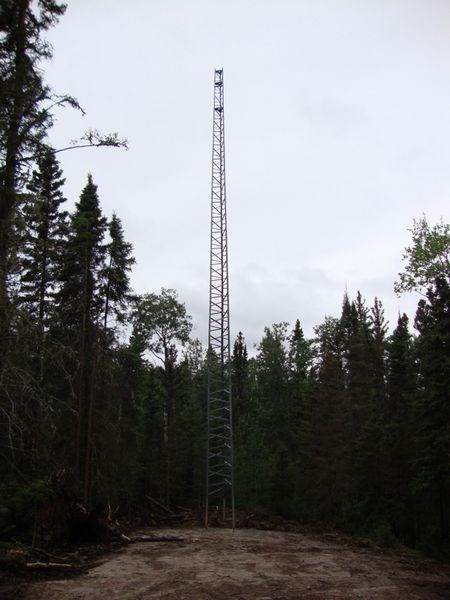Years of waiting, both online and off, have finally come to an end for folks in Snow Lake's cottage subdivisions. The days of slow dial up service and expensive two-way satellite feeds are over and the era of wireless Internet is now here and available to many previously unreachable areas within the Town of Snow Lake's limits.
Snow Lake's Steve Davies and Commstream Communications (formerly Gillamnet) are responsible for bringing cottagers into the 21st Century; Davies by installing a 75-foot communications tower on his Taylor Bay property - and Commstream by installing the equipment on the tower to extend area coverage.
Tom Motyka of Commstream says the initiative evolved after he was approached by Snow Lake's Cottage Owner's Association about expanding their service to the cottages. "Even though a couple of people were already able to get the service, the coverage was very spotty, since there is high ridge blocking the signal path between most of the cabins and the (Herblet Lake) Hydro Tower," Motyka advised in an e-mail interview. "Only a handful of people that had line of sight to the tower were able to get the service reliably."
In stepped Davies, who with the help of friends, installed the tower and paved the way for Commstream's installations.
In relation to accessing the new service, Motyka states Commstream is quite confident that all of Berry Bay, Taylor Bay, Bartlett Landing, and Anderson Bay will be covered, as well as any further developments in the area. He also notes that Herb Lake Landing is already covered and has been able to get Commstream's service for the last three years. Although they are 19 miles away from the Herblet tower, their line of sight is clear straight across Wekusko Lake.
Although the provider's maximum speed is about 3Mbps downstream (downloading) and up to 1 Mbps upstream (uploading), on average people in the cottage subdivisions will see about 2Mbps down and 500kbps up, which is about 50 times faster than regular dial-up. "It operates at a lower frequency than the system we have set up in the Town of Snow Lake because it must penetrate all the trees and foliage in the area," Motyka explained. "If demand dictates, we will put up multiple Access Points in order to increase the total available bandwidth, but seeing as it would take at least 30 people to start maxing out the capacity, it will probably not be required anytime soon."
Motyka advises that Commstream is also looking forward to Manitoba Hydro's fibre optic cable that is being run to Snow Lake. "This will enable Commstream to offer speeds of up to 10Mbps downstream and up to 4Mbps upstream to the residential customers in the Town of Snow Lake," he said. "We will also be able to offer businesses 10Mbps or even 100Mbps symmetrical service. We are very excited about the new possibilities."
When asked how Commstream's new service to the community's cottages compares to current providers, Motyka says that the monthly cost is roughly the same as DSL (digital subscriber line), at about $44.95 plus tax, and is much cheaper than two way satellite service. "However, because of the expense of the radios, we have to use in order to deliver the service wirelessly through the trees, the upfront cost is $300," said Motyka. "This does include the installation, where a tech will come out and install the service.
He says that wireless Internet service providers down south charge similar up front rates and even higher monthly fees than Commstream does in the north. "People must realize that generally cable modem and DSL technology is cheaper, because there are dozens of manufacturers making the equipment and the equipment is standardized; meaning that equipment from different manufacturers is interoperable," he continued. "This drives down the cost significantly. In the fixed wireless area (doesn't refer to Wi-Fi) there are only a couple of major players making this sort of equipment. It is proprietary and the market for it is much smaller than it is for cable modems and DSL modems, meaning prices remain high. The average cost of one of the modems that we use is about eight times the cost of a cable modem. Also, the installation is much more involved, since we generally need to install the radio outside with an antenna and run the cables inside to the computer. Most people; however, realize that there are sacrifices that are made if you want to live outside a major centre and to be able to get the same sort of high speed Internet service is worth the bit of extra upfront cost."




